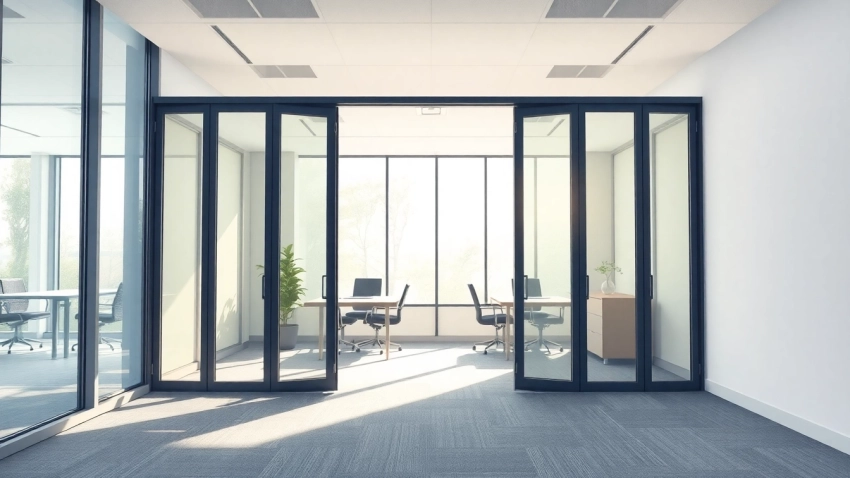
Maximize Space Efficiency with Folding Partition Walls for Versatile Interiors
Understanding Folding Partition Walls
In today’s dynamic environment, the need for versatile spaces—whether in a residential, commercial, or event setting—has led to innovative solutions in interior design. One such solution is the Folding Partition Wall, which allows users to create flexible spaces that can be easily expanded or contracted as necessary. This article will explore the different aspects of folding partition walls, from what they are to their design considerations, installation processes, maintenance, and successful case studies showcasing their use.
What is a Folding Partition Wall?
A folding partition wall is a movable wall system designed to divide spaces with ease while maintaining aesthetic appeal and functionality. These walls provide an efficient solution for creating temporary or permanent divisions in a room. Unlike traditional walls, folding partitions can be opened and closed, allowing for flexibility to modify the layout of a space according to specific needs.
Types of Folding Partitions
Folding partition walls come in various types to suit different applications and preferences:
- Accordion Folding Partitions: These feature a series of panels connected by hinges that can collapse to one side, similar to an accordion. Ideal for spaces that require quick transformations.
- Operable Walls: More robust than accordion models, operable walls offer superior acoustic control, making them ideal for conference rooms and areas needing sound privacy.
- Glass Partitions: For a modern aesthetic, glass partitions let in light while still demarcating space. They are often used in offices or contemporary homes.
- Acoustic Partitions: Specifically designed to reduce sound transmission, these partitions are perfect for environments like theaters or multi-use facilities.
Benefits of Using Folding Partition Walls
The advantages of folding partition walls go beyond their space-saving capabilities:
- Flexibility: Easily reconfigure space for different events or purposes, accommodating gatherings, meetings, or private work areas.
- Cost-Effective: Reduces the need for extensive construction and permanent walls, allowing for budget-friendly remodeling.
- Sound Isolation: High-quality partitions offer soundproofing, improving privacy in shared environments.
- Enhanced Aesthetics: Available in various designs and finishes, folding partitions can complement existing décor, enhancing the overall look of a space.
Design Considerations for Your Space
Choosing the Right Style
When selecting a folding partition wall, consider the architectural style of the space. Modern, minimalist designs may favor sleek glass models, while traditional settings might benefit from wood or fabric-covered options. The choice of style can profoundly affect the room’s ambiance.
Material Options and Their Impact
Materials used in folding partitions contribute significantly to their function and aesthetic. Common choices include:
- Plywood: Often used for its durability and cost-effectiveness.
- Glass: Provides a contemporary feel with the advantage of natural light.
- Fabric: Used for acoustic panels, adding texture and warmth to the environment.
The material not only dictates the visual impact but also influences practicality in terms of maintenance and durability.
Color Schemes and Aesthetic Integration
Color selection for folding partition walls should be complementary to the existing interior design. Neutral tones can provide a timeless appeal, while bolder colors may serve as a design statement. It’s essential to integrate these elements smoothly to ensure continuity throughout the space.
Installation Process for Folding Partition Walls
Preparation and Planning
Before installation, thorough planning is essential. Assess the space available and the desired functionality of the partition. Consider factors such as:
- Location and dimensions of the wall
- Installation type (ceiling track or wall-mounted)
- Accessibility and flow of movement within the space
Proper planning can highlight potential issues such as structural obstacles or the need for electrical considerations.
Step-by-Step Installation Guide
The installation of folding partition walls generally follows these steps:
- Gather Materials: Ensure that all materials, including the partition panels, tracks, hardware, and necessary tools, are on hand.
- Measure and Mark: Using a measuring tape, mark the installation location accurately to ensure proper fit.
- Install Tracks: Secure the tracks to the ceiling or wall, ensuring they are level and correctly positioned.
- Hang Panels: Attach the panels to the tracks according to the manufacturer’s instructions, taking care to align them properly.
- Test Functionality: After installation, open and close the partition to ensure smooth operation.
Common Installation Challenges
Several challenges can arise during installation, including:
- Uneven Surfaces: Can cause issues with alignment. Solutions include using shims or leveling compounds.
- Misalignment: Regular adjustments are crucial if issues occur during installation.
- Weight Distribution: Ensure that the tracks can support the weight of the panels to avoid sagging.
Maintenance of Folding Partition Walls
Cleaning and Care Tips
Regular cleaning of folding partition walls helps maintain their functionality and aesthetics. Here are some care tips:
- Dusting: Regularly dust the surface to prevent build-up that affects appearance.
- Spot Cleaning: Use mild detergents for stains that might appear, especially on fabric-covered panels.
- Check Mechanisms: Periodically inspect tracks and hinges for smooth operation and lubrication needs.
Identifying Common Issues
Be vigilant for signs of wear or damage, such as panels not aligning properly or excessive noise during operation. Quick identification of these issues can prevent more significant problems down the line.
When to Seek Professional Help
If difficulties persist despite maintenance efforts, it may be wise to consult with professionals. Scenarios that necessitate professional intervention include:
- Persistent alignment issues
- Structural concerns
- Complex repair needs that exceed basic maintenance
Case Studies: Successful Applications of Folding Partition Walls
Commercial Spaces
In commercial settings, folding partition walls have proven invaluable for maximizing space. For instance, an office building utilized operable walls to convert a large conference room into smaller meeting spaces, increasing its versatility and utility across departments.
Residential Applications
Homeowners have capitalized on the benefits of folding partitions to create adaptable living areas. A family may employ these walls to separate an open-plan living space into a more intimate configuration while still offering the option for a larger, more connected area when needed.
Flexible Solutions for Event Spaces
Event venues increasingly adopt folding partition walls to host a variety of functions. For example, a banquet hall can transform into multiple smaller venues for workshops or private parties, thus enhancing revenue potential through more diverse bookings.












Leave a Reply